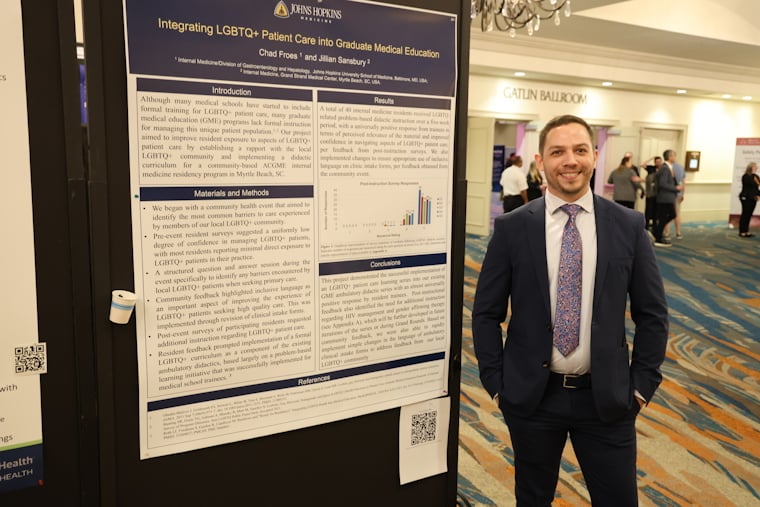Studies show that members of the LGBTQIA+ community (lesbian, gay, bisexual, transgender, queer, intersex, asexual, and all sexual and gender minorities), are less likely to see a physician than heterosexual patients due to fear of discrimination and/or past discriminatory experiences. In the poster, “Integrating LGBTQ+ Patient Care into Graduate Medical Education,” Dr. Chadley Froes explains how he worked to implement changes in his program to make clinical intake forms more inclusive and increase residents’ confidence in treating this underserved population.
Poster Title: Integrating LGBTQ+ Patient Care into Graduate Medical Education
Lead Author Name: Chadley Froes, MD
Co-Author: Jillian Sansbury, MD, FACP, FHM
ACGME: Tell us about your academic and professional role.
Dr. Froes: Currently I am working as a clinical fellow in neurogastroenterology and gastrointestinal motility. At the time of this project, I was in my final year of internal medicine residency.
ACGME: Can you briefly describe your research project for us?
Froes: The project started as a community health symposium with the goal of encouraging direct interactions between physicians (including both residents and attendings) and members of our local LGBTQIA+ population, ideally with the goal of identifying and addressing common barriers experienced by LGBTQIA+ patients in our community when seeking high-quality patient care. We provided an educational seminar for community members in attendance, which was followed by an open Q-and-A session to facilitate open dialogue. These discussions identified two key areas of improvement that served as the focus of the project moving forwards: improved training of residents regarding the specific needs of LGBTQIA+ patients; and implementation of more inclusive language on clinical intake forms. Per this feedback, we implemented an LGBTQIA+ focused problem-based learning series that was incorporated into our existing ambulatory didactic curriculum. We also made adjustments to clinic and hospital intake forms to include language such as preferred sex, biological sex, preferred name, and biological name.
ACGME: What inspired you to do this project?
Froes: This project was partly inspired by the results of our annual ACGME [Resident] Survey, which highlighted the need to improve my residency program’s instruction regarding diversity, equity, and inclusion (DEI), specifically including LGBTQIA+ patient populations. However, as a personal member of the LGBTQIA+ community, I also felt a sense of responsibility to give my fellow learners the knowledge and resources needed to deliver high-quality care to all patients (including those identifying as LGBTQIA+). I also wanted to set an example for other LGBTQIA+ residents who may have wanted to pursue similar quality improvement efforts. Editor’s note: The ACGME added DEI-related questions to its Annual Update and ACGME Surveys during the 2019-2020 period.
ACGME: What did you discover?
Froes: All 40 residents in our program participated in didactic sessions over a five-week period, with extremely positive feedback from all participants. We were pleasantly surprised that the only recurring critique was that residents wanted more information about more specific topics, including aspects of HIV management and hormonal replacement therapy. Moreover, we were easily able to modify existing clinical intake forms to provide more inclusive language, both in our ambulatory and inpatient environments.
ACGME: What was the main takeaway?
Froes: My main take away from the project was that efforts to improve resident exposure to LGBTQIA+ patient care can be cheaply and relatively easily accomplished, especially when incorporated into existing didactics. The problem-based format also made didactic sessions more engaging for residents and implementation within existing ambulatory didactics meant that we could accomplish our goals without taking more time away from residents’ busy schedules.
ACGME: Who could benefit from this research?
Froes: I feel that any program leaders who are motivated to improve resident education and training regarding specific at-risk populations (such as LGBTQIA+ or similar underserved socioeconomic or ethnic minority groups) could easily employ a similar strategy to improve the educational program at their institution. This entire project was accomplished in about six to eight months with no additional funding and using only graduate medical education (GME) resources. We were also grateful to have the help of a local LGBTQIA+-focused non-profit organization, who helped to recruit community members to our health symposium.
ACGME: Anything else you’d like to add?
Froes: To anyone who is interested in implementing similar changes in GME: be bold and take small steps towards making those changes a reality! Try not to let your own perceptions or fears discourage your efforts, since most medical learners will actually respond well to new approaches to training, especially those that create more well-rounded physicians or facilitate a more nuanced understanding of different patient populations. Feel free to email me (cfroes1@jh.edu) if you’re interested in learning more about this project or would like some materials to get started at your own institution.

